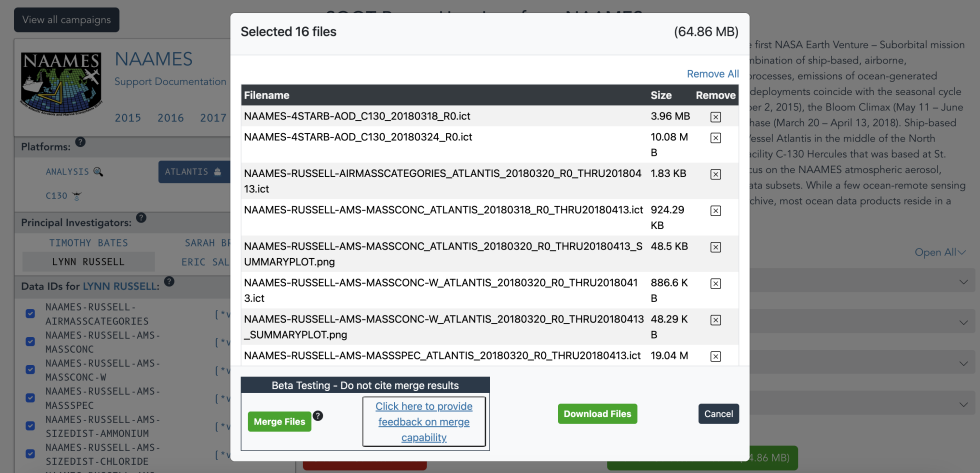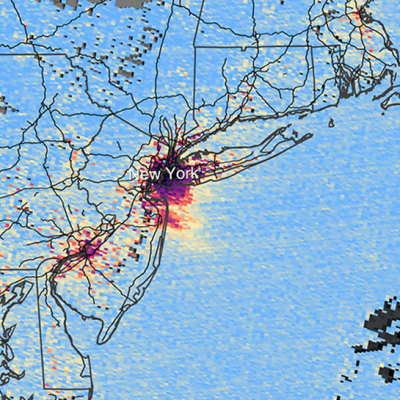Sub-orbital field campaigns, which contain a variety of surface measurements, airborne sensors on aircraft and balloons, ground-based instruments, sondes, and other instruments, have a long history of being used to study atmospheric composition, including climate change and air quality impacts. They are also used to connect satellite observations and ground-based measurements.
Although the variety of instruments used in these studies help scientists capture comprehensive information about atmospheric processes, the sampling techniques they employ and the data products they produce can encompass a wide array of complex variables, which can make them difficult to use. These unique attributes of sub-orbital data often require specialized approaches for ingesting, archiving, discovering, and distributing the data from sub-orbital campaigns.
The Sub-Orbital Order Tool (SOOT) developed by NASA’s Atmospheric Science Data Center (ASDC) at NASA’s Langley Research Center in Hampton, Virginia, was specifically designed to address the distinctive characteristics of sub-orbital data while supporting the discovery, access, and use of data from the sub-orbital campaigns archived at ASDC.
“One of the problems that people who use data from suborbital campaigns face is that many of the online tools designed for data access are specifically focused on, or were initially designed for, satellite data,” said Jennifer Tindell, product owner for the ASDC's Transformation Development team. “Sub-orbital data have many nuances that aren't addressed by these tools. [SOOT] was built to address that.”
The release of SOOT in March 2021 introduced a Power User Interface (UI) intended for experienced data users and science teams with extensive knowledge of the attributes and nuances of sub-orbital data. The UI offers advanced filter options with two main goals, the first being a survey study where users can select a few variables for all flights and the second being a process study where users can select all variables for one flight. The tool incorporates a streamlined data ingest process and customized metadata parsing, allowing users to discover data variables from multiple studies and platforms. “Right now, SOOT includes only data [distributed by ASDC]. When we released it, it had [data from] eight campaigns. Now it has 16,” said Tindell.
“SOOT is significant because of the key features that it offers,” said Tindell. “It allows people to directly choose their products based on a descriptive data product identifier or data ID, and gives them the ability to view and filter data on a common platform.”
SOOT’s key features, functionality, and versatility are most evident in the way it lets users select, refine, review, and download data.
SOOT’s Power UI offers in-depth campaign metadata enabling enhanced data search capabilities, and its refined search options help users find the Principal Investigator (PI) and the associated data files needed for their analyses. In addition, users can further refine their data selections with the dataID, a short description of the measured parameter or species, instrument, or model prefixed by the mission's name that is included at the beginning of file names. Further, within specific dataIDs, users can explore a range of variables prior to downloading the file.
After users choose the data they're interested in, they can review their selection by using the "Review Selected Files" button in the interface to obtain an overview of the files selected and the volume of the download. This enables users to verify that they have the data they need and delete any unnecessary files. When everything is in order, users can download the data using the "Download Files" button. Downloaded data are neatly packaged in a zipped file featuring the tool name, the mission the data are from, and the date of download.
In addition to data, SOOT also provides efficient access to the documentation associated with each of the 16 sub-orbital field campaigns it supports.
“The links [in the documentation] take users from the SOOT website to the ASDC website, which features information on every campaign [ASDC archives], such as a description about the campaign itself, the instruments used, the data products it produced, publications—all of it is right there at users’ fingertips,” Tindell said.
Tindell and her colleagues are also planning a number of improvements to SOOT that will be incorporated into the tool as they become available. Chief among these is a so-called “merge service” that will enable users to align data to a common time base and view all of the data products from the same campaign, platform, date, and launch in one file, thereby preventing users from reviewing these products across multiple files. Other planned enhancements include:
- Improved access to resources designed to help users become aware and take full advantage of SOOT’s capabilities
- An interface designed for general users that will guide them through the process of finding, accessing, reviewing, and downloading sub-orbital data and provide greater access to contextual information
- Integration of SOOT functionality into Earthdata Search with the inclusion of all sub-orbital campaign data regardless of which NASA Distributed Active Archive Center (DAAC) is ingesting and archiving the data
Although there is no timeline for when these improvements will be completed, their implementation will not impede the ultimate aim of SOOT, which is to provide users of sub-orbital data with the information they need to help them locate, access, and obtain the data that best meet their needs.
“Here you've got all of the variables you need to quickly scan through the available data to see if this is the data you really want, as opposed to downloading a ton of data that you have to look through to see if [the data are] what you need,” said Tindell. “[SOOT] provides all of the support pieces to help users make informed decisions about the data that are going to be most useful.”
NASA's ASDC is one of 12 DAACs in NASA’s Earth Observing System Data and Information System (EOSDIS). ASDC manages, archives, and distributes NASA Earth science data related to radiation budget, clouds, aerosols, and tropospheric composition, and provides tools and applications for working with these data. These data are important for understanding the causes and processes of global climate change and the consequences of human activities on Earth’s atmosphere and climate.
Accessing SOOT
On the ASDC website, click the Sub-Orbital Order Tool (SOOT) link under the word USE along the bottom of the home page. Users can also access SOOT directly via the tool’s URL.
Resources
There are a number of resources to help users make the most of SOOT’s capabilities, including:
- SOOT Overview Storymap: Sub-Orbital Order Tool (SOOT) Power User Interface Overview
- ASDC Micro Article: Accessing Airborne and Field Campaign Data with the Sub-Orbital Order Tool
- NASA Earthdata Webinar: Powered Up Data—Getting to Know the Sub-Orbital Order Tool (SOOT) Power User Interface


